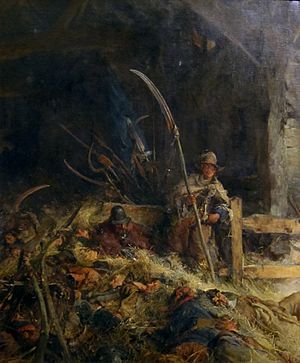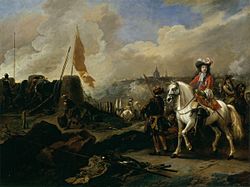Battle of Sedgemoor facts for kids
Quick facts for kids Battle of Sedgemoor |
|||||||
|---|---|---|---|---|---|---|---|
| Part of the Monmouth Rebellion | |||||||
 The Morning of Sedgemoor, Edgar Bundy |
|||||||
|
|||||||
| Belligerents | |||||||
| Commanders and leaders | |||||||
| Strength | |||||||
| 3,000 | 4,000 | ||||||
| Casualties and losses | |||||||
| 200 killed or wounded | 1,300 killed or wounded 2,700 captured |
||||||
The Battle of Sedgemoor was the last major fight of the Monmouth Rebellion. This rebellion was an attempt by the Duke of Monmouth to take the throne of England. The battle happened on 6 July 1685, near Westonzoyland in Somerset, England. The English Royal Army won a clear victory against Monmouth's rebel forces.
This battle was the final event of the Monmouth Rebellion. It followed several smaller fights across south-west England. The rebels, led by the Duke of Monmouth, fought against the Royal Army, which was loyal to King James II. After the Royal Army won, about 500 rebels were captured. Monmouth himself escaped the battlefield but was caught nine days later. He was taken to London and executed. Many of his supporters faced severe punishments during what was known as the Bloody Assizes. Some were sent away to other countries, while others were executed.
Contents
Why the Battle of Sedgemoor Happened
The Battle of Sedgemoor was the last big fight in the Monmouth Rebellion. In this rebellion, James Scott, 1st Duke of Monmouth, tried to become King of England. He wanted to take the throne from his uncle, James II of England. James II had become king after his brother, King Charles II, died on 2 February 1685. The Duke of Monmouth was Charles II's son, but he was not born in a marriage.
Monmouth started his rebellion by landing in Lyme Regis in Dorset from the Dutch Republic. After that, his army marched and fought in small battles across Dorset and Somerset. Eventually, Monmouth's army, which was not well-equipped, was pushed back. They ended up trapped in Bridgwater by 3 July. Monmouth told his troops to make the town stronger for defense. His army had about 3,500 people. Most of them were Protestant farmers and artisans. They were often armed with farm tools like pitchforks instead of proper weapons.
The Royalist troops were led by Louis de Duras, 2nd Earl of Feversham, and Colonel John Churchill. They set up their camp behind a ditch called the Bussex Rhine at Westonzoyland. The Royal Army was made up of professional soldiers. These included famous regiments like the Royal Scots and the Grenadier Guards. They also had cavalry, which were soldiers on horseback, and artillery, which were cannons.
How the Battle of Sedgemoor Unfolded
The Duke of Monmouth decided to lead his untrained army out of Bridgwater. They left around 10:00 pm to try a surprise night attack on the King's army. A local farmer's servant, Richard Godfrey, guided them. They followed an old road towards Bawdrip. Their small group of cavalry rode at the front. They turned south along Bradney Lane and Marsh Lane. This led them to the open moor, which had deep and dangerous ditches called rhynes.
There was a delay as the rebels tried to cross a rhyne. The first rebels to cross accidentally startled a Royalist patrol. A shot was fired, and a horseman from the patrol quickly rode off to tell Feversham. Lord Grey of Warke led the rebel cavalry forward. They were met by the King's Regiment of Horse. This fight warned the rest of the Royalist forces that an attack was happening. The King's army had better training and more experienced soldiers and horses. They were able to defeat the rebel cavalry by surrounding them.
What Happened After the Battle
Monmouth escaped the battlefield with Lord Grey. They tried to get to the south coast, dressed as peasants. They were caught near Ringwood, Hampshire. Monmouth was taken to the Tower of London, where he was executed.
After the battle, about 500 of Monmouth's soldiers were captured. They were held in St Mary's Parish Church in Westonzoyland. Other rebels were hunted down and shot in the ditches where they were hiding. Many more were hanged from gallows set up along the roads. The Royalist troops were rewarded for their victory. Feversham became a Knight of the Garter. Churchill was promoted to Major-General. Other soldiers received money, especially those who were wounded. Some wounded soldiers were among the first to be treated at the new Royal Hospital Chelsea.
King James II sent Lord Chief Justice Jeffreys to find and punish the Duke's supporters. This became known as the Bloody Assizes. Trials were held at Taunton Castle and other places. About 1,300 people were found guilty. Many were sent away to other countries. Some were executed. Daniel Defoe, who later wrote the famous book Robinson Crusoe, had joined the rebellion. He was heavily fined by Jeffreys and lost much of his land and money.
King James II himself was overthrown just three years later. This happened in a peaceful change of power called the Glorious Revolution.
The Last Battle on English Soil
The Battle of Sedgemoor is often called the last battle fought on English soil. However, what counts as a 'battle' can be interpreted in different ways. Other events that some consider the last English battle include:
- The Battle of Preston in Lancashire, fought on 14 November 1715, during the First Jacobite Rebellion.
- The Second Jacobite Rebellion's Clifton Moor Skirmish, near Penrith, Cumberland, on 18 December 1745.
The Battle of Culloden, fought near Inverness in Scotland on 16 April 1746, was the last major battle fought on British soil.
Images for kids
See also
 In Spanish: Batalla de Sedgemoor para niños
In Spanish: Batalla de Sedgemoor para niños






